by Dan Eden for ViewZone
As usual, viewzone gave me an assignment that seemed literally out of this world. They asked me to investigate the theory that some major earthquakes can be caused by explosions far, far away in the universe. Although I'm not entirely convinced that this can happen, the evidence is pretty convincing.
The Earthquake in Chile (8.8)
Before we discuss the material below we need to mention the earthquake that happened in Chile on February 27, 2010. There are now many reports coming in that strange lights were seen in the sky a few hours before the event [below].

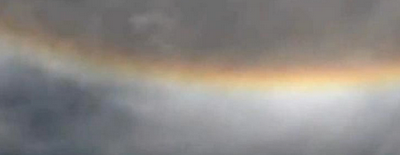

This was what people saw i the evening sky in Chile -- just hours before the earthquake.
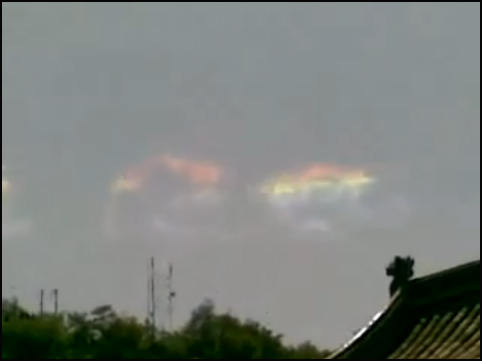
[above:] This image was taken just hours before the powerful 7.9 earthquake in Sechuan, China, on May 12, 2008.
This was recorded in Tianshui, Gansu province, about 450km northeast of epicenter, by someone using a cell phone. The Chinese earthquake killed about 70,000 people.
In February 2009, a growing number of American and Chinese scientists openly proclaimed that the calamity was triggered by a four-year-old reservoir built too close to the earthquake's geological fault line. A Columbia University scientist who studied the quake has said that it may have been triggered by the weight of 320 million tons of water in the Zipingpu Reservoir less than a mile from this well-known major fault. His conclusions, presented to the American Geophysical Union in December, coincide with a new finding by Chinese geophysicists that the dam caused significant seismic changes before the earthquake.
Strange lights in the sky have been reported for many years in regions where earthquakes follow by a few hours. Until now the link between these lights and the earthquakes has been a mystery. Now scientists may have a clue about what is producing both phenomenon. The following theory suggests that some of these powerful earth moving events may have their origin in space, while others may be man made. However in both circumstances, the strange lights may serve as an efficient warning of underground stress and impending danger.
Earthquakes from Space
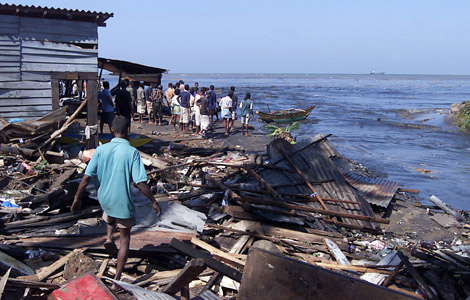
The idea started with one of the most powerful earthquakes that was ever recorded -- the magnitude 9.3 earthquake that occurred in the Indian Ocean off the coast of Sumatra in Malaysia on December 26th, 2004. It caused a powerful tsunami which devastated coastal regions of many countries leaving over 240,000 people either dead or missing. It was the worst tsunami to affect this area since the 1883 explosion of Krakatao. The earthquake that produced it was so strong that it exceeded by a factor of 10 the next most powerful earthquake to occur anywhere in the past 25 years.
Just 44.6 hours later, scientists were shocked to see that gamma ray telescopes orbiting the Earth picked up the arrival of the brightest gamma ray burst ever recorded! The Gamma ray burst (or GRB) arrived from deep space on December 27, 2004 at 21 hours 36 minutes (Universal Time) and was 100 times more intense than any burst that had been previously recorded. It equaled the brightness of the full Moon but radiated most of its energy at gamma ray wavelengths. The blast temporarily changed the shape the Earth's ionosphere, distorting the transmission of long-wavelength radio signals.
Was there a relationship between these two dramatic events? Perhaps.
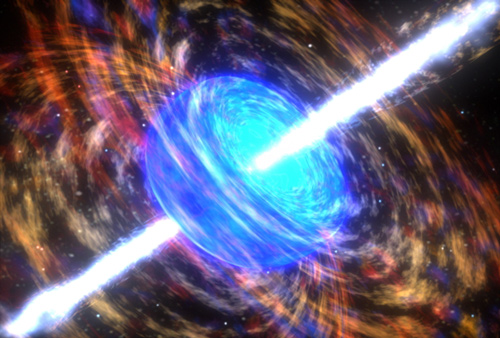
When stars die, they typically expand and give off a lot of energy. If a star is large enough, the core will collapse and a tremendous amount of energy will be released in a supernova explosion. This is so powerful that a single supernova will be brighter than an entire galaxy full of hundreds of billions of stars! But the very brightest supernovae, the biggest stars that explode, can produce ultra-powerful jets that shoot out in opposite directions. If one of those jets (which are really narrow, only about one degree wide) is pointed directly at us, we get bathed in a whole lot of extra energy even beyond what a supernova can do, and that's called a gamma ray burst.
Gamma rays are the most lethal form of radiation. These are the kind of rays that kill people from an atomic blast. The gamma rays can penetrate deep inside biologic tissue and alter molecular structures and rip apart the very basis of life. We are extremely lucky that we have not experienced a close encounter with a gamma ray burst -- most have been many light years away -- because if we had, you would not be reading this.
Gamma ray bursts are detected frequently in our universe. Most of the bursts are outside our Milky Way Galaxy, far, far away. Satellites detect these bursts and report on their position and strength, often allowing astronomers to look at the sources and try to understand what causes them. Although most are thought to be collapsing stars or black holes, others remain a mystery.
Gamma Rays and Gravity waves
Astronomers have theorized that gamma ray bursts might travel in association with gravity wave bursts. The same events, such as a rapidly collapsed star, which cause the release of gamma rays also is thought to make a "ripple" in the time-space continuum that is manifested as a gravity wave.
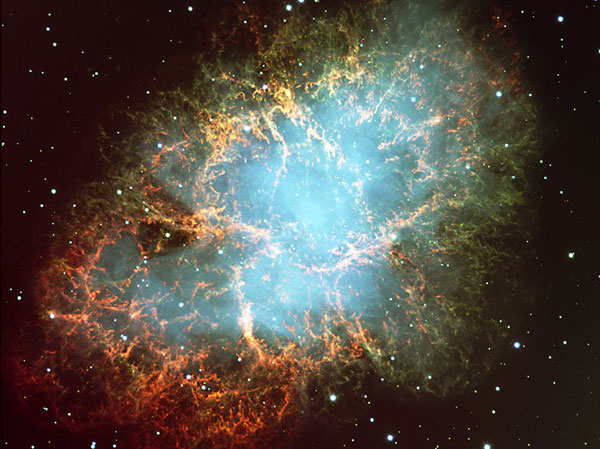
The "Crab Nebula" is the remnant shell of a star that exploded many years ago. At the time it collapsed on itself, it would have sent out powerful gamma ray bursts and gravity waves.
In the course of their flight through space, gamma rays would be deflected by gravitational fields and would be scattered by dust and cosmic ray particles they encountered, so they would be expected to travel slightly slower than their associated gravity wave burst which would pass through space unimpeded.
In this analogy, if space were a liquid, gamma rays would be energy traveling through the liquid whereas the gravity wave would be the waves of the liquid itself.
After a 45,000 year light-speed journey, a gamma ray burst arrival delay of 44.6 hours (as in the case of the December 2004 earthquake/gamma ray burst) would not be unexpected. It amounts to a delay of just one part in 9 million.
So if the gravity wave traveled at the speed of light (c), the gamma ray burst would have averaged a speed of 0.99999989 c, just 0.11 millionths slower. There is also the possibility that at the beginning of its journey the gravity wave may have had a superluminal (greater than velocity of c) speed.
But the gravity waves are not always created at the same instant as the gamma ray bursts. The rapid collapse of a star produces a gravity wave and may precede the formation of the gamma ray beams which originate from the poles of the collapsed star. So it is possible that the gravity waves get a "head start" in advance of the GRBs.
Still with me on this? Here's what's going on so far:
Collapsing stars release massive amounts of energy that travel outward in the form of powerful gamma rays, called gamma ray bursts. These huge explosions last only minutes but can be detected from orbiting satellites. These violent explosion also causes a ripple in the very fabric of space-time -- like a stone thrown in a pond -- and travel outward as a gravity wave. Both the gamma rays and gravity wave propagate outward at different speeds, often reaching the earth at different times.
So What is a Gravitational Wave?
Most scientists describe gravitational waves as "ripples in space-time." Just like a boat sailing through the ocean produces waves in the water, moving masses like stars or black holes produce gravitational waves in the fabric of space-time. A more massive moving object will produce more powerful waves, and objects that move very quickly will produce more waves over a certain time period.
Where Do Gravitational Waves Come From?
Gravitational waves are usually produced in an interaction between two or more compact masses. Such interactions include the binary orbit of two black holes, a merge of two galaxies, or two neutron stars orbiting each other. As the black holes, stars, or galaxies orbit each other, they send out waves of "gravitational radiation" that reach the Earth. However, once the waves do get to the Earth, they are extremely weak. This is because gravitational waves, like water waves, decrease in strength as they move away from the source. Even though they are weak, the waves can travel unobstructed within the 'fabric' of space-time. This how they are able to reach the Earth and provide us with information that light cannot give.

Gravitational waves have two important and unique properties. First, there is no need for any type of matter to be present nearby in order for the waves to be generated by a binary system of uncharged black holes, which would emit no electromagnetic radiation. Second, gravitational waves can pass through any intervening matter without being scattered. Whereas light from distant stars may be blocked out by interstellar dust, for example, gravitational waves will pass through unimpeded. These two features allow gravitational waves to carry information about astronomical phenomena never before observed by humans.
What are the effects of a passing gravitational wave?
[Top Right]The effect of a plus-polarized gravitational wave on a ring of particles.
[Bottom right]The effect of a cross-polarized gravitational wave on a ring of particles.
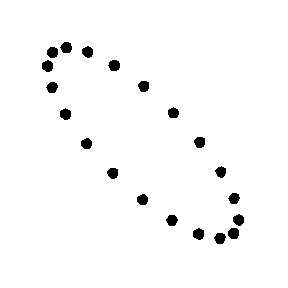 Imagine a perfectly flat region of spacetime, with a group of motionless test particles lying in a plane. Then, a weak gravitational wave arrives, passing through the particles along a line perpendicular to the plane of the particles. What happens to the test particles? Roughly speaking, they will oscillate in a "cruciform" manner, as shown in the animations. The area enclosed by the test particles does not change, and there is no motion along the direction of propagation. In the animation at the right, the wave would be passing from you, through the screen, and out the back.
Imagine a perfectly flat region of spacetime, with a group of motionless test particles lying in a plane. Then, a weak gravitational wave arrives, passing through the particles along a line perpendicular to the plane of the particles. What happens to the test particles? Roughly speaking, they will oscillate in a "cruciform" manner, as shown in the animations. The area enclosed by the test particles does not change, and there is no motion along the direction of propagation. In the animation at the right, the wave would be passing from you, through the screen, and out the back.
The foregoing animation is the result of a pair of masses that orbit about each other (e.g., black holes) on a circular orbit or a rotating rod or dumbbell. In this case the amplitude, A, of the gravitational wave is a constant, but its plane of polarization changes or rotates (at twice the orbital or rotating-rod rate) and so the time-varying gravitational wave size or periodic spacetime strain h, exhibits a variation as shown in the animation. If the orbit is elliptical or the rotating rod's centrifugal-force change varies during rotation, then the gravitational wave's amplitude (that is, the amplitude of the periodic spacetime h), A, actually also varies with time according to an equation called the "quadrupole".
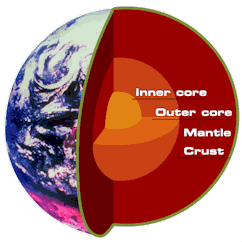 The effect of Gravity Waves on the Earth
The effect of Gravity Waves on the Earth
In his 1983 Ph.D. dissertation, Paul LaViolette called attention to terrestrial dangers of Galactic core explosions, pointing out that the arrival of the cosmic ray superwave they produced would be signaled by a high intensity gamma ray burst which would also generate a strong gravity wave that might be expected to travel forward at the forefront of this superwave and might be the first indication of a superwave's arrival. He pointed out that such gravity waves could induce substantial tidal forces on the Earth during their passage which could induce earthquakes and cause polar axis torquing effects.
If a gravity wave can distort the space between matter, even on a small scale, the cumulative effect of the earth's core, with its dense mass, and the mantle could result in movement of the crust. The result would be an earthquake.
While we still do not know the relationship of the arrival on earth of the gamma ray burst and the gravity wave, we would expect that they should coincide within several hours of eachother for near sources, to many days of eachother if the source is distant. Sometimes we would expect an observed GRB to follow a seismic event by as much as 48 hours (for very distant yet powerful objects) and they may precede seismic events by as much as a few days or a week, owing to the time needed for mantle and core stress to affect the faults.
To test this hypothesis, we have researched the most notable gamma ray bursts from 1967 to the present.
|
Strong Gamma Ray Burst (date) |
Earthquake Reported (date) |
|
GRB 20100319A -- This gamma ray blast, on March 19, 2010, was recorded by the SWIFT satellite at 18:34:50 Universal Time at RA 18:33:46 DEC -08:32:13.
|
On March 20, 2010 at 18:08:09 Universal Time, a magnitude 5.6 occurred in Guantanamo, Cuba. Location: 19.731 N, 75.279 W; Depth 17.2 km (10.7 miles)
On March 20, 2010 at 14:00:51 Universal Time, a magnitude 6.2 occurred in Papua, New Guinea. Location: 3.380 S, 152.231 E; 423.5 km (263.2 miles)
|
| GRB 20100317A -- This gamma ray blast, on March 17, 2010, was recorded by the SWIFT satellite at 04:43:54 Universal Time at RA 11:40:04 DEC -46:18:51. |
On March 17, 2010 a magnitude 5.4 occurred in South Sumatra. Location 4.701 S, 102.757 E, depth 67.9 kn (42.2 miles).
|
| Very unusual group of Gamma Ray Bursts!
GRB 20100316A -- This gamma ray blast, on March 16, 2010, was recorded by the SWIFT satellite at 02:23:00 Universal Time at RA 16:48:07 DEC 71:49:31.
GRB 20100316B -- This gamma ray blast, on March 16, 2010, was recorded by the SWIFT satellite at 08:01:36 Universal Time at RA 10:53:59 DEC -45:28:47.
GRB 20100316C -- This gamma ray blast, on March 16, 2010, was recorded by the SWIFT satellite at 08:57:59 Universal Time at RA 02:09:09 DEC -68:00:32.
GRB 20100316D -- This gamma ray blast, on March 16, 2010, was recorded by the SWIFT satellite at 12:44:50 Universal Time at RA 07:10:27 DEC -56:16:40.
GRB 20100316E -- This gamma ray blast, on March 16, 2010, was recorded by the SWIFT satellite at 13:37:41 Universal Time at RA 22:01:01 DEC -52:12:09.
|
On March 15, 2010 at 18:54:23 Universal Time, a magnitude 4.8 occurred in Sumatra, Indonesia. Location: 1.161 N, 97.103 E; Depth 39.1 km (24.3 miles)
On March 16, 2010 at 09:44:18 Universal Time, a magnitude 5.8 occurred in Japan. Location: 52.160 N, 142.206 E; Depth 24.1 km (15.0 miles)
On March 16, 2010 at 11:07:15 Universal Time, a magnitude 4.7 occurred in Greater Los Angeles, California. Location: 33.9992 N, 118.082 E; Depth 18.9 km (11.7 miles)
On March 16, 2010 at 11:04:00 Universal Time, a magnitude 4.4 occurred in Sakhalin, Russia. Location: 53.759 N, 142.362 E; Depth 10.0 km (6.2 miles)
On March 16, 2010 at 12:25:26 Universal Time, a magnitude 5.4 occurred in Fiji Region. Location: 17.668 N, 178.827 E; Depth 566.1 km (351.8 miles) - extremely deep!
On March 17, 2010 at 00:22:32 Universal Time, a magnitude 5.1 occurred in South of Tonga. Location: 24.190 N, 175.943 E; Depth 33.9 km (21.1 miles)
|
| GRB 20100305A -- This gamma ray blast, on March 05, 2010, was recorded by the SWIFT satellite at 09:05:38 Universal Time at RA 11:13:27 DEC 42:22:34. This burst had a single peak lasting about 20 seconds. The XRT started observing the field 139 seconds after the trigger, finding a bright uncatalogued x-ray source within the BAT error circle. The UVOT also imaged the field, but it found no optical candidate in its 122 second unfiltered image. |
On March 08, 2010 a magnitude 6.0 occurred in Eastern Turkey, killing 51 people with aftershocks magnitude 5.5 A 4.4-magnitude earthquake struck Hawaii on Monday evening, according to the U.S. Geological Survey.
March 08, 2010 The quake struck about 6:30 p.m. (11:30 p.m. ET) and was 19.3 miles (31.1 km) deep. The epicenter was 13 miles (20 km) southwest of the coastal region of Laupahoehoe and 189 miles (304 km) east of Honolulu, the USGS said.
|
| GRB 20100302A -- This gamma ray blast, on March 02, 2010, was recorded by the SWIFT satellite at 19:53:06 Universal Time at RA 13:-1:22 DEC 74:34:50. Swift slewed immediately to this burst, which consisted of a broad peak that started about 40 seconds after the trigger and lasted about 35 seconds. The XRT began observing the field 125 seconds after the trigger, finding a bright, fading, uncatalogued x-ray source within the BAT error circle. The UVOT made a 150 second unfiltered exposure beginning 132 seconds after the trigger, but no OC was seen. |
On March 3, 2010 a magnitude 6.4 occurred in Taiwan. Location: 22.903 N, 120.823 E; Depth 23.1 km (14.4 miles) |
| GRB 20100219A -- This gamma ray blast, on February 19, 2010, was recorded by the SWIFT satellite at 15:15:46 Universal Time at RA 10:16:52 DEC -12:33.32 |
On February 27, 2010 a magnitude 8.8 occurred off the coast of Chile. It was the strongest earthquake to strike the region in 50 years and generated a tsunami that impacted the entire Pacific rim area.
Magnitude 7.0, Friday, February 26, 2010 at 20:31:27 UTC, Location: 25.902 N, 128.417 E; Depth 22 km (13.7 miles);
Region: RYUKYU ISLANDS, JAPAN |
| GRB 100111A -- This gamma ray blast, on January 11, 2010, was recorded by the SWIFT satellite at 04:12:49 Universal Time at RA 16:28:09 DEC 15:33:24 |
On January 12, 2010 a magnitude 6.8 occurred in Haiti, destroying buildings and infrastructure and causing over 200,000 deaths. |
| GRB 100103A On January 03, 2010 at 17:41:03 -- This burst had a duration of 40 seconds.
The Swift satellite observed the field 54 seconds after the INTEGRAL trigger, finding an uncatalogued x-ray source with the XRT. No source was found with the UVOT, with lower limits v > 20.44, u > 20.70 (GCN 10310). Additional Swift/XRT observations showed that the source was fading approximately 55 hours after the trigger, thus confirming that it was the GRB afterglow (GCN 10313).'' |
January 03, 2010, Magnitude 7.1 in SOLOMON ISLANDS. Sixteen homes
destroyed, at least 60 damaged and 1,000 people left homeless on
Rendova. Some of the damage was caused by a tsunami, with a
runup height of 2-3 m on Rendova. Felt (VI) at Gizo. The tsunami
was recorded at the following tide stations with these wave
heights (peak-to-trough): 2 cm at Cape Ferguson and 15 cm at
Rosslyn Bay, Australia; 13 cm at Honiara, Solomon Islands; 1 cm
at Luganville, Vanuatu.
|
| GRB 091123 on November 23, 2009 -- This burst was extremely unusual. The GBM light curve showed four emission peaks separated by long quiet periods. However, comparison with Konus-Wind data showed that the burst was already occurring when its position rose above the limb of the Earth as seen from Fermi. Using only the GBM data the burst duration was 650 seconds.
|
NOV 24, 2009 magnitude 6.8 in TONGA. |
| GRB 091003 on October 03, 2009 -- ''This burst had multiple peaks. It lasted approximately 21 seconds. The spectrum was fit by a Band function with alpha = -1.13 +/- 0.01, beta = -2.64 +/- 0.24 and Epeak = 486.2 +/- 23.6 keV.
|
OCT 04, 2009 magnitude 6.6 MORO GULF, MINDANAO, PHILIPPINES. |
| GRB 090929N on September 29, 2009 -- The BAT light curve for this burst has a complex structure with multiple peaks from T-10 seconds to T+50 seconds. Additional weaker peaks are seen at T+150 seconds, with the peak count rate occurring approximately 40 seconds after the trigger. The satellite slewed immediately to the burst and began XRT observations 84 seconds after the trigger. A bright, uncatalogued x-ray source was found within the BAT error circle. The UVOT also imaged the field starting 93 seconds after the trigger. In a 97 second unfiltered exposure there is not OC found.
|
September 29, 2009 magnitude 8.1 in the SAMOA ISLANDS REGION. At least 149
people killed in Samoa, 34 killed in American Samoa and 9
killed, 7 injured and 500 displaced on Niuatoputapu, Tonga.
Widespread damage to infrastructure occurred at Pago Pago,
American Samoa, in many parts of Samoa and on Niuatoputapu,
Tonga. Nearly all of the casualties and damage was caused by
large tsunamis, with run up heights of 12 m at Poloa, 7 m at
Pago Pago and Tula, American Samoa and 3 m on Niuatoputapu. Felt
(V) at Apia, Samoa and (IV) at Ili`ili and Tafuna, American
Samoa. Felt in much of American Samoa, Samoa and northern Tonga
and as far away as Wallis and Futuna Islands. The tsunami was
recorded with the following wave heights (peak-to-trough) on
these selected tide stations: 411 cm at Pago Pago, American
Samoa; 140 cm at Apia, Samoa; 111 cm at Rarotonga, Cook Islands;
64 cm in the Chatham Islands, 37 cm at Raoul, 21 cm at Tauranga,
14 cm at Gisborne, 11 cm at Wellington, New Zealand; 28 cm at
Nuku`alofa, Tonga; 29 cm at Papeete, French Polynesia; 25 cm at
Luganville, Vanuatu; 36 cm at Honolulu, Hawaii; 22 cm at Point
Kemblao, Australia; 66 cm at Crescent City and 26 cm at Los
Angeles, California; 42 cm at Cabo San Lucas, Mexico; 11 cm at
Old Harbor and 4 cm at Seward, Alaska; 36 cm at Ofunato, Japan;
27 cm on Baltra, Ecuador; 73 cm at Antofagasta and 40 cm at
Valparaiso, Chile.
September 30, 2009 magnitude 7.5 in SOUTHERN SUMATRA, INDONESIA. At least 1,117
people killed, 1,214 injured, 181,665 buildings destroyed or
damaged and about 451,000 people displaced in the Padang-
Pariaman area. Landslides disrupted power and communications in
the area. Felt (VII) at Padang; (VI) at Bukittinggi; (IV) at
Bengkulu, Duri, Mukomuko and Sibolga; (III) at Pekanbaru. Also
felt (IV) at Gunungsitoli, Nias and (II) at Jakarta, Java. Felt
throughout Sumatra and in much of Java. Felt (III) in Singapore
and at George Town, Johor Bahru, Kuala Lumpur, Petaling Jaya,
Shah Alam and Sungai Chua, Malaysia. Felt in much of Peninsular
Malaysia and as far away as Chiang Mai, Thailand. A 27-cm
(center-to-peak) local tsunami was recorded at Padang, Sumatra.
|
| GRB 090922A on September 22, 2009 -- The main pulse of this burst lasted 10 seconds, and it was followed by a weaker pulse approximately 60 seconds later. The total burst duration was about 92 seconds. The time-averaged spectrum was fit by a Band function with alpha = -0.77 +/- 0.05, beta = -2.28 +/- 0.07 and Epeak = 139.3 +/- 6.6 keV.
|
September 21, 2009 magnitude 6.1 BHUTAN. At least eleven people killed and dozens
injured in Mongar and Tashigang. Many buildings destroyed and
many roads damaged throughout Bhutan. Cracks appeared in
buildings at Guwahati, India. Felt (VI) at Tashigang and (IV) at
Thimphu, Bhutan. Also felt at Tshongdue. Felt (II) at Calcutta,
India. Also felt at Barpeta, Bidhannagar, Dispur, Guwahati,
Kalimpong, Mussoorie, Nagaon, Nalbari, North Dum Dum, Patna,
Shillong, Silchar, Tezpur and Tura. Felt in northern Bangladesh,
at Lhasa, China and at Kathmandu, Nepal. |
| GRB 090904B on September 02, 2009 -- This burst had a single bright pulse lasting about 21 seconds. It was also independently detected by the INTEGRAL SPI-ACS. The spectrum was fit by a Band function with alpha =-0.696 +/- 0.012, beta = -3.85 +0.21/-0.31 and Epeak = 775 +/- 11 keV. The burst was also seen in the LAT (GCN 9867).
|
September 02, 2009 magnitude 7.0 in JAVA, INDONESIA. At least 81
people killed, more than 1,297 injured, 25,000 displaced and
severe damage in western Java, including at least 30 people
killed and 27 missing due to a landslide at Cikangkareng. Felt
(VII) at Tasikmalaya; (VI) at Cianjur and Sukabumi; (V) at
Bandung, Bekasi, Bogor and Purwakarta; (IV) at Cibinong,
Cikarang, Ciputat, Cirebon, Depok, Jakarta, Pekalongan, Serpong,
Tangerang and Yogyakarta; (III) at Karangkates, Klaten,
Semarang, Sleman, Tretes and Wonosari. Felt widely on Java. Felt
(IV) at Denpasar and (II) at Kuta, Bali. Also felt at Ubud. Felt
at Jambi and Metro, Sumatra and on Sumbawa. Felt (V) in
Singapore.
|
| GRB 090829B on August 29, 2009 -- This burst lasted approximately 100 seconds and had two widely separated peaks. The spectrum was fit by a Band function with alpha = -0.7 +/- 0.2, beta = -2.4 +/- 0.5 and Epeak = 143 +/- 30 keV. |
August 30, 2009 magnitude 6.6 in the SAMOA ISLANDS REGION. Felt at Pago Pago, American Samoa. Also felt at Aoloau, Aua, Fagatogo, Leone, Mapusagafou, Tafuna, Vailoatai and Vatia. Felt at Apia, Samoa. Also felt at
Lalovi and Vailoa. |
| GRB 090828 on August 28, 2009 -- This light curve had three pulses with a total duration of ~100 seconds. The spectrum was fit by a Band function with alpha = -1.23 +0.06/-0.05, beta = -2.12 +0.08/-0.11 and Epeak = 136.5 +16.0/-13.7.
|
August 28, 2009 magnitude 6.9 in the BANDA SEA. Felt at Karangkates, Kupang, Makasar and Namlea and on Bali, Indonesia. Also felt at Mataram. Felt at Dili, Timor-Leste. |
| GRB 090815A on August 15, 2009 -- This burst was quite long, lasting 200 seconds. It had a single broad pulse. The spectrum was fit by a simple power-law with an index of -1.15 +/- 0.1. |
August 16, 2009 magnitude 6.7 in the KEPULAUAN MENTAWAI REGION, INDONESIA. A tsunami with a wave height (peak-to-trough) of 36 cm was recorded at Padang.
August 17, 2009 magnitude 6.7 in the SOUTHWESTERN RYUKYU ISLANDS, JAPAN. |
| GRB 090812A on August 12, 2009 -- This burst had a triple-peaked structure and a duration of approximately 70 seconds. The XRT began observing the field 77 seconds after the trigger: A bright, uncatalogued x-ray source was found within the BAT error circle. The UVOT also observed the field, beginning 298 seconds after the trigger. A candidate OC was found with U = 18.62.
|
August 12, 2009 magnitude 6.6 in the IZU ISLANDS, JAPAN REGION. |
| GRB 090809B on August 09, 2009 -- This burst consisted of a single pulse in the GBM. It lasted approximately 15 seconds. The spectrum was fit using a Band function with alpha=-0.85 +/- 0.04, beta = -2.02 +/- 0.06 and Epeak = 198 +/- 13 keV. |
August 09, 2009 magnitude 7.1 NEAR THE SOUTH COAST OF HONSHU, JAPAN.
August 10, 2009 magnitude 7.5 in ANDAMAN ISLANDS, INDIA REGION.
August 10, 2009 magnitude 6.1 NEAR THE SOUTH COAST OF HONSHU, JAPAN. One person
killed, 123 people injured and 5,192 buildings damaged in the
Shizuoka area. One road damaged at Tokyo. |
| GRB 090715B on July 15, 2009 -- The BAT showed a multipeaked light curve lasting approximately 100 seconds. Swift slewed immediately to this burst, starting XRT observations 46.2 seconds after the trigger. A bright, uncatalogued x-ray source was found in the BAT error circle. The UVOT took an unfiltered 150 second finder chart exposure beginning 53 seconds after the trigger. A faint object was detected near the XRT source, near the edge of the XRT error circle. The magnitude is estimated to be 20.5 +/- 0.5.
|
July 15, 2009 magnitude 7.8 OFF WEST COAST OF THE SOUTH ISLAND, N.Z. A water main was broken at Winton, walls of buildings were
cracked at Invercargill and items fell from shelves throughout
Southland. Power outages occurred in several parts of the South
Island. Several small landslides were also reported. Geodetic
measurements indicate the southern tip of the South Island
shifted as much as 35 cm to the west-southwest. Felt (VI) at Te
Anau and Tuatapere; (V) at Arrowtown, Edendale, Lumsden and
Winton; (IV) at Bluff, Gore, Invercargill, Outram, Queenstown
and Wanaka. Felt throughout the South Island, the southern part
of the North Island and as far away as southeast Australia. A
tsunami with wave heights in centimeters (peak-to-trough) was
recorded at the following stations: 100 at Jackson Bay; 25 at
Charleston; 12 at Dog Island, New Zealand; 14 at Port Kembla and
6 at Spring Bay, Australia.
|
| GRB 090709A on July 09, 2009 -- This burst had four major peaks, with the first occurring about 20 seconds before the trigger and continuing for about 100 seconds after the trigger. The satellite slewed immediately to the burst and began observing with the XRT after 68 seconds. A fading, uncatalogued object was found within the BAT error circle. The UVOT began observing 76 seconds after the trigger, but no OC was found in the initial data analysis. |
July 09, 2009 magnitude 5.7 in YUNNAN, CHINA. One person killed, 336 people injured and
severe damage in the Yao'an area. Felt (III) at Dali and
Kunming. Also felt at Xichang. Felt at Bangkok, Thailand.
|
| GRB 090706 on July 06, 2009 -- The GBM showed two peaks lasting a total of ~100 seconds. The spectrum was fit by a simple power law with index -2.16 +/- 0.09.
|
July 04 2009 magnitude 6.0 in PANAMA. At least 32
people injured and 10 buildings damaged (V) in the Panama City
area. Felt (V) at Alcaldediaz, Balboa, Cativa, Cerro Azul,
Chame, La Cabima, Las Guias, Margarita, Tocumen and Veracruz;
(IV) at Ancon, Anton, Arraijan, Colon, La Chorrera, Las Cumbres,
Penonome, Sabanitas and San Miguelito; (III) at Bejuco,
Chilibre, Nueva Gorgona, Paraiso, Puerto Pilon, Taboga and Vista
Alegre. Also felt at Almirante, Boquete, Caimitillo, Cerro Cama,
Chepo, Chitre, Cocle, El Espino, El Porvenir, Gatun, La
Herradura, Las Tablas, Maria Chiquita, Nargena, Nuevo Arraijan,
Pacora, Portobelo, Puerto Caimito, Remedios, Rio Hato, Rio Rita,
Sajalices, San Carlos, Santa Clara, Santiago and Santo Domingo.
Felt (II) at Barranquilla, Colombia. Also felt at Cartagena and
Santa Marta.
|
| GRB 090612 on June 12, 2009 -- The GBM light curve showed a single strong pulse which was preceded by a weak pre-trigger. The total duration of the burst was ~ 58 seconds. The spectrum was fit using a Band function with alpha = -0.6 +/- 0.1, beta = -1.9 +/- 0.1 and Epeak = 357 +/- 59 keV. |
June 13, 2009 magnitude 5.4 in EASTERN KAZAKHSTAN. One person died of a heart attack
and several buildings damaged (VII) at Tekeli. Felt (III) at
Almaty. Also felt at Druzhba and Ushtobe. Felt at Yining, China.
|
| GRB 090528A on May 28, 2009 -- This burst lasted ~ 68 seconds. The light curve had one major pulse with structure. The spectrum was fit by a power law with exponential cutoff. The index is -1.7 +/- 0.1 and the cutoff energy is Epeak = 99 +/- 26 keV.
GRB 090528B on May 28, 2009 -- The GBM light curve showed multiple peaks with a weak structured tail. The duration of the burst was 102 seconds. The spectrum was fit with a power law and exponential cutoff: index = -1.10 +- 0.04, Epeak = 172 +/- 12 keV.
|
May 28, 2009 magnitude 7.3 OFFSHORE HONDURAS.
At least 7 people killed, 40 injured and more than 130 buildings
damaged or destroyed in northern Honduras, including the Islas
de la Bahia. The central span of a major bridge at El Progreso
was destroyed. Felt (VII) at El Progreso, Jose Santos Guardiola,
La Lima, Omoa, Puerto Cortes and Utila; (VI) at French Harbor,
La Ceiba, Roatan, Sambo Creek, San Pedro Sula, Sandy Bay and
Tela; (V) at Arizona, Guanaja, Mateo, Santa Rosa de Copan,
Siguatepeque, Tocoa and Villanueva. At least 5 buildings
destroyed and 25 damaged in Belize. Felt (VI) at Dangriga; (V)
at Belize City, Benque Viejo and Punta Gorda; (IV) at Belmopan,
San Ignacio and San Pedro. Felt (V) at Colon and (IV) at Antiguo
Cuscatlan, Mejicanos, San Miguel and San Salvador, El Salvador.
Felt (VI) at Livingston and Puerto Barrios; (V) at Villa
Canales; (IV) at Antigua Guatemala, Chichicastenango,
Chimaltenango, Chiquimula, Coban, Fraijanes, Guatemala, Mixco
and Villa Nueva, Guatemala. Felt (III) at Carmen, Chetumal,
Merida and Villahermosa; (II) at Cancun and Mexico, Mexico and
(II) at Havana, Cuba. Felt throughout Belize, El Salvador and
Guatemala and in much of Honduras. Also felt in The Bahamas,
Cayman Islands and the Virgin Islands and in parts of Colombia,
Costa Rica, Cuba, Jamaica, Mexico, Nicaragua and Panama. Seiches
were reported in swimming pools at La Ceiba and Roatan, Honduras
and ground cracks and possible liquefaction were observed at
Monkey River, Belize.
|
| GRB 090502 on May 02, 2009 at 18:39:34 Universal Time -- The burst lasted about 66 seconds and showed multiple peaks. The spectrum was fit by a power law with exponential cutoff: index = -1.1 +/- 0.3, Epeak = 63.2 +/- 8.7 keV. |
May 02, 2009 magnitude 4.3 in GREATER LOS ANGELES AREA, CALIFORNIA. (PAS). One person injured in the Los Angeles area. Felt (IV) at
Westlake Village; (III) at Agoura Hills, Avalon, Bell, Burbank,
Calabasas, Camarillo, Chino Hills, Compton, Culver City, Encino,
Garden Grove, Gardena, Hermosa Beach, Inglewood, Malibu, Marina
del Rey, Moorpark, Newbury Park, Oak Park, Pacific Palisades,
Panorama City, Paramount, Playa del Rey, Reseda, Santa Monica,
Sherman Oaks, Simi Valley, Tarzana, Thousand Oaks, Valley
Village and Van Nuys; (II) throughout Los Angeles and Orange
Counties, in much of Ventura County and in western Riverside and
San Bernardino Counties. Felt as far as Lompoc, Palm Springs and
San Diego
|
| GRB 090407 on April 7, 2009 -- This burst lasted at least 150 seconds. It had a multipeaked structure, with a small peak near T+135 seconds. The XRT began observing the field 93 seconds after the trigger. It found a fading, uncatalogued x-ray source within the BAT error circle. In unfiltered images taken with the UVOT beginning 97 seconds after the trigger, no obvious OC was discovered.
|
April 06, 2009 magnitude 6.3 in CENTRAL ITALY.
At least 295 people killed, 1,000 injured, 55,000 homeless,
15,000 buildings damaged or destroyed and landslides in the
L'Aquila area. Felt (VII) at L'Aquila; (VI) at Corfinio and San
Demetrio ne' Vestini; (V) at Avezzano, Chieti, Pescara, Rieti,
San Benedetto del Tronto, Sulmona and Teramo; (IV) at Amelia,
Ancona, Ascoli Piceno, Castelfrentano, Fiumicino, Fondi,
Francavilla al Mare, Frosinone, Guidonia, Isernia, Lanciano,
Latina, Macerata, Montesilvano, Naples, Osimo, Pesaro, Rome and
Terni. Felt throughout central Italy and as far north as
Florence, Milan and Venice and as far south as Bari and Salerno.
Also felt in San Marino and at Vienna, Austria; Tirana, Albania;
Knin, Croatia; Nuremberg, Germany; San Gwann, Malta; Celje,
Slovenia; Zurich, Switzerland and Podgorica, Montenegro. |
| GRB 090319 on March 19, 2009 The burst had two distinct peaks of duratoin ~6 seconds which sat atop a smooth component lasting ~68 seconds. The first peak was centered at T0+13 and T0+30 seconds, respectively. The spectrum was best fit by a power law with exponential cutoff: index = 0.90 +/- 0.10 and Epeak = 187.3 +/- 20.4 keV. |
March 19, 2009 magnitude 7.6 in the TONGA REGION. Felt at Havelu, Neiafu, Pangai
and Vaini. Also felt at Suva, Fiji; Auckland, Lower Hutt,
Taradale and Wellington, New Zealand; Apia, Samoa. A small
tsunami was generated with wave heights (peak-to-trough, in cm.)
at the following selected tide stations: 10.4 at Iquique, Chile;
17.3 at Rarotonga, Cook Islands; 5.7 at Suva, Fiji; 27.0 at
Santa Cruz, Galapagos Islands; 10.0 at Honolulu, 18.6 at Kahului
and 9.4 at Nawiliwili, Hawaii; 20.3 at Nuku Hiva and 14.5 at
Hiva Oa, Marquesas Islands; 10.0 at Napier, New Zealand; 8.7 at
Niue; 22.8 at Callao, Peru; 10.7 at Port-Vila, Vanuatu. |
| GRB 090113 on January 13, 2009 -- This burst lasted 20 seconds. The satellite slewed immediately and the XRT began observing 71 seconds after the trigger. No x-ray source was detected. Similarly, in a 150 second finder chart exposure (unfiltered) taken with the UVOT beginning 79 seconds after the trigger, no OC was found. Subsequent analysis of the XRT data did reveal an uncatalogued source within the BAT error circle (GCN 8806). Monitoring of the source showed it to be decaying according to a power law, suggesting that this was indeed the afterglow of the GRB (GCN 8811).
|
January 15, 2009 magnitude 6.7 SOUTHEAST OF THE LOYALTY ISLANDS.
January 15, 2009 magnitude 7.4 EAST OF THE KURIL ISLANDS. |
| GRB 080405 0n January 07, 2009 -- The duration of this burst was 20 seconds. It had a two-peaked light curve and was also detected by the Fermi GBM as trigger 25303844, with duration of 24 seconds and two-peaked structure, as seen by INTEGRAL (GCN 8793). This same structure was seen by WAM on Suzaku; in the WAM energy band the burst lasted only 14 seconds (GCN 8794). |
January 08, 2009 magnitude 6.1 in COSTA RICA. At least 23
people killed, 100 injured and 17 missing in central Costa Rica.
Many of the casualties were caused by landslides. A total of 518
houses destroyed or damaged at Barrio Fatima de Heredia, Barrio
Santa Cecilia de Aserri, Cinchona, Dulce Nombre de Alajuela,
Infiernillo, Leon XIII, Los Guido, Poasito, Rio Cuarto, Sabana
Redonda, Santa Rosa de Poas and Vara Blanca. Roads were damaged
in the Cinchona and Vara Blanca areas and bridges were destroyed
or damaged at Los Angeles, Rio Cuarto de Grecia and Bajos del
Toro. Electricity was disrupted in parts of San Jose. Felt (VII)
at Naranjo and (VI) at Alajuela, Asuncion, Cinco Esquinas,
Escazu, Grecia, Heredia, Llorente, Mercedes, Sabanilla, San
Francisco, San Jose, San Josecito, San Juan, San Pablo, San
Rafael, San Vicente and Santa Ana. Felt throughout Costa Rica
and in southern and central Nicaragua.
|
| GRB 090102 on January 02, 2009 -- The BAT-detected burst had a duration of approximately 30 seconds and showed a multi-peaked light curve, with some emission starting about 15 seconds prior to the trigger. The XRT began observing the field 387 seconds after the trigger and found a bright, uncatalogued x-ray source within the BAT error circle. The UVOT also began observing the field (T0+395), and in a 150 second unfiltered image found an m = 18.1 object
|
January 03, 2009, magnitude 7.7 NEAR THE NORTH COAST OF PAPUA, INDONESIA. A tsunami was recorded
with the following wave heights (peak-to-trough): 78 cm at
Manokwari, 38 cm on Biak and 20 cm at Jayapura, Indonesia; 13.0
cm at Ishigakijima, 10.2 cm at Naha, 30.7 cm at Omaezeki and
30.8 cm at Tosashimizu, Japan; 0.8 cm on Yap, Federated States
of Micronesia; 20.0 cm on Saipan, Northern Mariana Islands; 3.7
cm at Malakal, Palau; 5.2 cm on Wake Island. |
| GRB 080413A --
On April 13, 2008 Swift slewed immediately upon detection of this burst and began observing with the XRT (T+60 seconds) and UVOT (T+76 seconds). The XRT found a bright, fading uncatalogued source. The UVOT found an afterglow candidate with m=15.2. The burst had a duration of 55 seconds, and showed a triple-peaked structure (GCN 7594).
GRB 080411A -- On April 11, 2008 Swift slewed immediately to this burst and started XRT observations 71 seconds after the trigger. A very bright x-ray source was found near the center of the field. However, due to issues with the telemetry, the prompt data was lost for this source. Also, no data were immediately available from the UVOT. Subsequent UVOT data showed a bright candidate, with m = 17.01 approximately 70 minutes after the trigger (GCN 7592).
|
Huge earthquake in Setchuan province of China April 12, 2008. The earthquake was 7.9 magnitude and killed about 70,000 people. Although the blame was placed on a dam that was constricted near a known fault line, it is also believed that some natural event triggered the fault line to erupt. |
| GRB 990123 --
Astronomers obtained a visible-light image of GRB 990123 as it occurred on January 23, 1999, using the ROTSE-I telescope, sited in Los Alamos, New Mexico. The robotic telescope was fully automated, responding to signals from NASA's BATSE instrument aboard the Compton Gamma Ray Observatory within seconds, without human intervention. This was the first GRB for which optical emission was detected before the gamma-ray emission had ceased. GRB 990123 had the brightest measured optical afterglow until GRB 080319B. GRB 990123 momentarily reached exceeded magnitude 8.9, and would have been visible with an ordinary pair of binoculars in spite of its distance of nearly 10 billion light years from Earth. |
El Quindio, Columbia Earthquake , January 24, 1999: Reconnaissance Report. Eduardo A. Fierro, tech ed. On January 24, 1999 a 5.9 magnitude earthquake struck the western part of Colombia, causing more than 1,000 deaths and thousands of injuries. Within a matter of seconds entire city blocks were destroyed and thousands left homeless. Much of the damage resulted from poor construction and large amplifications of ground motions due to soft soil conditions. Numerous landslides disrupted roads and impeded emergency response. |
| GRB 970228 --
On February 27, 1997 the BeppoSAX satellite detected GRB 970228 and its afterglow. This was the first GRB with a successfully detected afterglow. The location of the afterglow was coincident with a very faint galaxy, providing strong evidence that GRBs are extragalactic. |
Earthquake felt across much of UK Feb. 27, 1997. The earthquake caused damage to many homes and wasn the biggest earthquake in the UK for nearly 25 years. People in Newcastle, Yorkshire, London, Cumbria, the Midlands, Norfolk and also parts of Wales, felt the tremor just before 0100 GMT. The British Geological Survey (BGS) said the epicentre of the 5.2 magnitude quake was near Market Rasen in Lincolnshire. |
| GRB 970508 --
May 8, 1997, was the first with a measured redshift, z = 0.835, confirming that GRBs are extragalactic events. The extent to which radiation is redshifted allows astronomers to calculate an estimate of the distance to the event from Earth. |
May 10, 1997: The Ardekul Earthquake northern Iran. Magnitude 7.3, Depth 33km. |
| GRB 080313 --
At 5th magnitude March 13, 2008 was an extremely intense GRB with the brightest visible afterglow ever. It was bright enough to see with the naked eye. At the time it was the most energetic event detected by Swift and the most luminous optical source ever recorded. GRB 080320A on March 20, 2008 Swift slewed immediately to this burst and began observing with the XRT 171 seconds after the trigger. A fading, uncatalogued x-ray source was found. Observations with the UVOT, starting 177 seconds after the trigger, did not detect any optical counterpart. |
Magnitude 7.2 - XINJIANG-XIZANG BORDER REGION, the March 20, 2008 event is one of the largest known historical earthquakes to have occurred in the northern Tibetan Plateau.
2008 March 20 22:33:00 UTC Preliminary Earthquake Report. Magnitude 4.3, Semnan Province Tuersday, March 18, 2008 at 03:56:49 (UTC).
March 18, 2008 at 03:56:49 ... Magnitude 3.3, E of Glacier Peak, WA
Monday March 17, 2008 at 04:58:48.26 PM (PDT) |
| GRB 080912 --
At 08:38:55 Universal Time on, September 12, 2008 was observed by Swift Satellite at RA 01:44:00, Dec --05:06:00. This burst had a single peak with a duration of 17 seconds. The spectrum in the 50 - 300 keV band is well fit by a power law with index -1.74+/-0.07. |
The USGS reports that a series of 4.5-4.8 magnitude earthquakes occurred on Thursday, September 11, 2008 between 5:17 p.m. and 7:26 p.m. EDT, 177-180 miles west of Neah Bay, Washington, at a depth of 6.2 miles. There were no reports of damage or injury and no tsunami was generated.
September 10, 2008 -- UAE hit by tremors after Iran earthquake.
Dubai: Severe tremors were felt in Dubai, Sharjah, Ajman and other parts of the emirates at around 3.08pm local time forcing people to flee from homes and office.
Magnitude 6.6 HALMAHERA, INDONESIA September 11, 2008. |
| GRB 080916C -- which occurred on September 16, 2008 in the constellation Carina and recorded by the Fermi telescope has been confirmed to have "the greatest total energy, the fastest motions, and the highest-energy initial emissions" ever seen. The explosion had the power of about 9,000 ordinary supernovae, and the gas bullets emitting the initial gamma rays must have moved at 99.9999 percent the speed of light. The tremendous power and speed make this blast the most extreme recorded to date. |
Strong 6.1 Earthquake East Timor 09/16/08, Indonesian seismological officials said the earthquake was 6.3.
Tuesday, September 16, 2008 07:15:41 PM, Earthquake measuring 4.7 shakes Maharashtra. The earthquake occured on Tuesday, September 16, 2008 at 21:47:14 UTC (Coordinated Universal Time ) and on Wednesday, September 17, 2008. |
| GRB 041227 -- This gamma ray blast, on December 27, 2004, was 100 times more intense than any burst that had been previously recorded, equaling the brightness of the full Moon, but radiating most of its energy at gamma ray wavelengths. Gamma ray counts spiked to a maximum in 1.5 seconds and then declined over a 5 minute period with 7.57 second pulsations. The blast temporarily changed the shape the Earth's ionosphere, distorting the transmission of long-wavelength radio signals. It is thought that gravity waves might have preceded the gamma rays. |
On December 26, 2004 a magnitude 9.3 earthquake occurred in the Indian Ocean off the coast of Sumatra in Malaysia. It caused a powerful tsunami which devastated coastal regions of many countries leaving over 240,000 people either dead or missing. It was the worst tsunami to affect this area since the 1883 explosion of Krakatao. The earthquake that produced it was so strong that it exceeded by a factor of 10 the next most powerful earthquake to occur anywhere in the past 25 years. |
| GRB 670702 --
On July 2, 1967, the first GRB, 670702, was detected by the Vela 4 satellite. |
A moderate earthquake measuring ML 4.1 (NCSN), Mw 4.1 (UCBSL) occurred at 17:33:53 UTC (10:33 a.m. local time), July 2, 1967 in the hills of Central California south of Hollister, but was too weak to topple any items from tables or shelves. |
What causes the strange lights in the sky?
If this theory is correct, the gravity waves cause the earth to stretch and contract at points where it is vulnerable -- like at certain fault lines. This movement causes sudden friction that generates enormous energy. As this energy reaches the surface it is in the form of plasma, a very unique form of energy that usually forms a toroid or donut shape. The plasma then energizes the surrounding atmosphere as it dissipates and this is seen as a glow or illumination.
So what's the verdict?
It appears that there is a link between the gamma ray bursts and the strong earthquakes. But this link assumes that the gamma ray bursts were associated with strong gravity waves. Unfortunately we do not have a record of gravity waves as they are felt on earth. In fact, they are still only theoretical.
In 1918, Albert Einstein predicted that cosmic events, such as collapsing stars, would radiate a propagating distortion of space and time -- gravitational waves. But after spending hundreds of millions of dollars to detect them, scientists have still come up empty.
Physicists worldwide have been fine-tuning enormous, multimillion-dollar machines to filter out background noise so they can observe the unique signatures of a gravitation wave. Before the decade is out, they believe they'll record the percussive crash of colliding black holes or the vibrant hum of a pulsar -- a discovery that would be the proverbial shot heard around the scientific world.
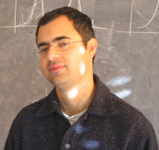 Stefano Foffa [right] of the University of Geneva is a member of a leading gravitational-wave-detection team, which includes 33 other scientists from Switzerland and Italy. They recently submitted a report to Classical and Quantum Gravity that details their so-far fruitless attempts at observing tiny gravitational tugs and distortions on Explorer, a supercooled, 3-meter-long aluminum bar at the CERN particle physics lab in Switzerland.
Stefano Foffa [right] of the University of Geneva is a member of a leading gravitational-wave-detection team, which includes 33 other scientists from Switzerland and Italy. They recently submitted a report to Classical and Quantum Gravity that details their so-far fruitless attempts at observing tiny gravitational tugs and distortions on Explorer, a supercooled, 3-meter-long aluminum bar at the CERN particle physics lab in Switzerland.
Explorer is particularly well-tuned to sense spinning neutron stars, also known as pulsars, Foffa said. He and his colleagues estimate that some 200,000 of these spinning, super-dense objects -- so dense that a just sugar cube-sized amount weighs as much as the entire human race -- are scattered throughout the Milky Way.
But the thermal noise of even supercooled atoms is greater than the momentary twang the bar's atoms would experience when being plucked by a passing gravitational wave. So the Explorer group must use sensitive superconducting circuits to coax out a signal. It's an art that's still being perfected.
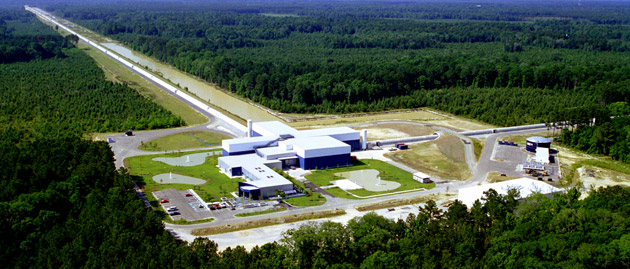
LIGO, the Caltech-MIT observatory, is an even bigger and more ambitious project than Explorer. To someone flying overhead, LIGO looks like an unfinished oil pipeline, with two mile-and-a-half long tubes jutting in perpendicular directions from a central building. The pipes (one in Livingston, Louisiana, and the other in Richmond, Washington), contain sensitive optics in which laser light bounces back and forth 100 times, then combines, allowing physicists to compare the two beams to monitor the space-time through which the light traveled.
The interference patterns from LIGO's two perpendicular laser beams sometimes momentarily jostle. If the same jostling happens at both LIGO's Louisiana and Washington detectors, and no earthquakes can explain the anomaly, then the source may well be a gravitational wave.
So, it's the million-dollar moment that hasn't yet happened. Or has it?
It could be that the effects of a relatively weak gravity wave can only be detected through the changes to some massive object, such as the earth's mantle. In that case the gravity wave theory may already have been validated by its association with earthquakes.
So there you have it.
Comments? || Viewzone Magazine
COMMENTS:
Hello Dan,
Congratulations for the article. Is very interesting to spread this theories to people and try to explain why earthquakes occur. I find much sense in this theory. I am a physicist and worried about these phenomena. I strongly recommend the reading about works and theories about "torsion fields", developed by russian astrophysicist Nicolai A. Kozyrev and other, from beginning of 20th century. Your article even gain more sense if we consider the existence of torsion fields (gravity is a consequence of torsion fields). Waves o ripples in a torsion field propagate almost "instantly". I think this would agree with the data about the great 2004 earthquake in Indonesia, 44 hours before the great GRB detected. If this was true, it would be convenient try to match otherwise the data about other historical earthquakes and GRBs, and try to construct another table.
Best regards,
Adolfovich
hello Dan,
very interesting theory. At first I was very sceptically, but after continuing reading I got the feeling that the theory could make sense.
However, one aspect seems to be flawed. If the gravity waves travel faster through space than the gamma ray bursts, how can it be possible that some earthquakes happen after the gamma ray bursts are recorded?
regards,
w3bst3r
We know that the gamma rays travel with velocity of light but we do not know how fast the gravity waves propagate. We think that they should be slower since they must expand and contract the space-time. This would mean that the gamma radiation would be detected before the gravity wave arrived. That is what the theoretical data is showing. Also, the gravity wave will not necessarily have an immediate effect on the earth's mantle in the form of an earthquake. It will expand and contract the mantle and set up the stress which will trigger an earthquake and this could take hours or days to manifest.
Keep in mind that we cannot yet measure the effects of a gravity wave because our instruments are expanding and contracting along with the material we attempt to measure.
Dan
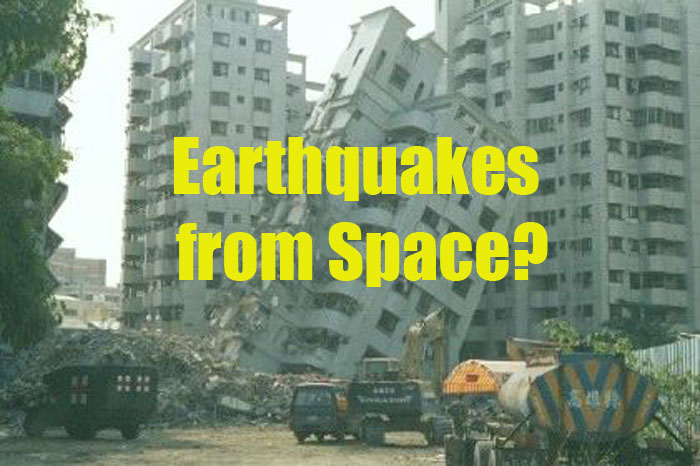









 Imagine a perfectly flat region of spacetime, with a group of motionless test particles lying in a plane. Then, a weak gravitational wave arrives, passing through the particles along a line perpendicular to the plane of the particles. What happens to the test particles? Roughly speaking, they will oscillate in a "cruciform" manner, as shown in the animations. The area enclosed by the test particles does not change, and there is no motion along the direction of propagation. In the animation at the right, the wave would be passing from you, through the screen, and out the back.
Imagine a perfectly flat region of spacetime, with a group of motionless test particles lying in a plane. Then, a weak gravitational wave arrives, passing through the particles along a line perpendicular to the plane of the particles. What happens to the test particles? Roughly speaking, they will oscillate in a "cruciform" manner, as shown in the animations. The area enclosed by the test particles does not change, and there is no motion along the direction of propagation. In the animation at the right, the wave would be passing from you, through the screen, and out the back. The effect of Gravity Waves on the Earth
The effect of Gravity Waves on the Earth Stefano Foffa [right] of the University of Geneva is a member of a leading gravitational-wave-detection team, which includes 33 other scientists from Switzerland and Italy. They recently submitted a report to Classical and Quantum Gravity that details their so-far fruitless attempts at observing tiny gravitational tugs and distortions on Explorer, a supercooled, 3-meter-long aluminum bar at the CERN particle physics lab in Switzerland.
Stefano Foffa [right] of the University of Geneva is a member of a leading gravitational-wave-detection team, which includes 33 other scientists from Switzerland and Italy. They recently submitted a report to Classical and Quantum Gravity that details their so-far fruitless attempts at observing tiny gravitational tugs and distortions on Explorer, a supercooled, 3-meter-long aluminum bar at the CERN particle physics lab in Switzerland.